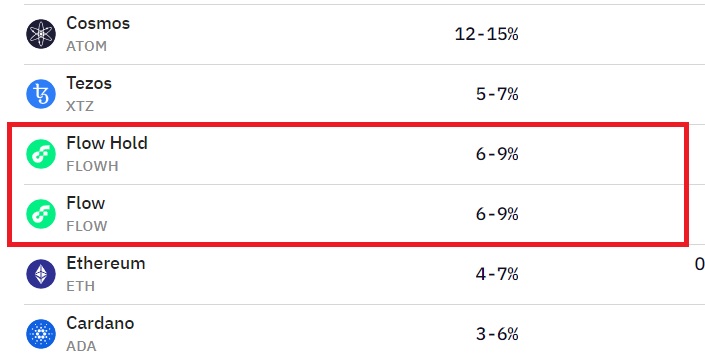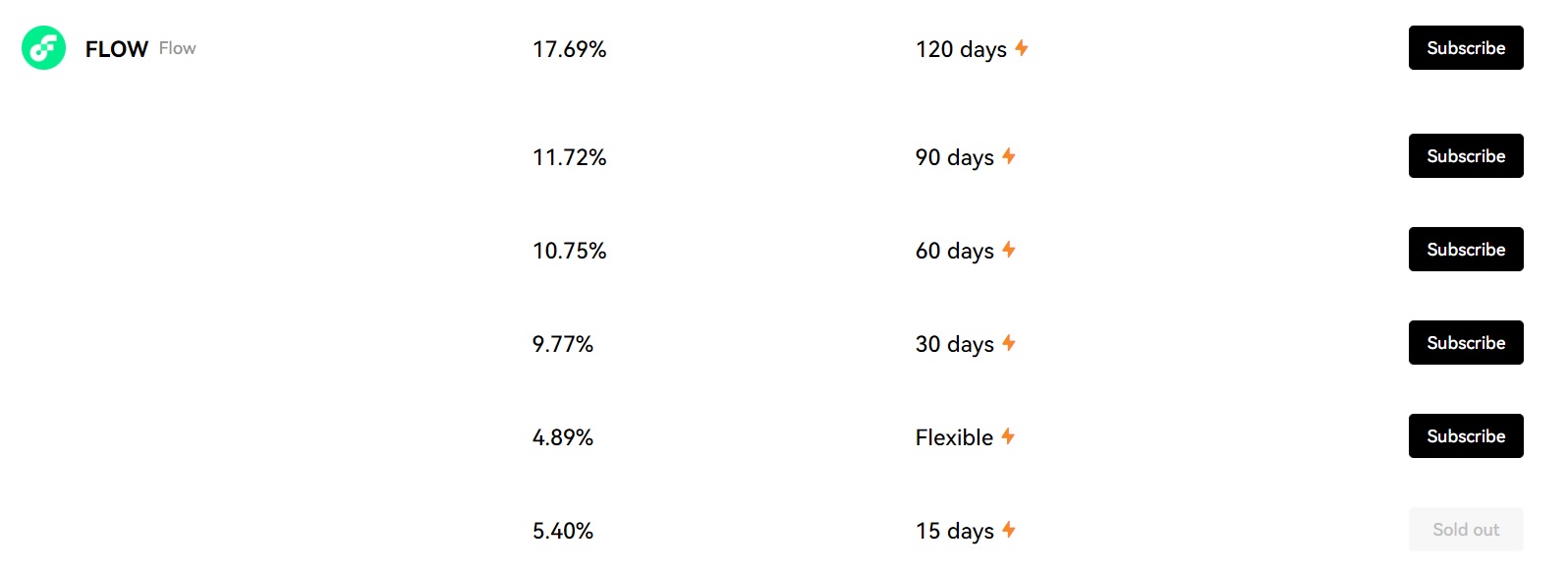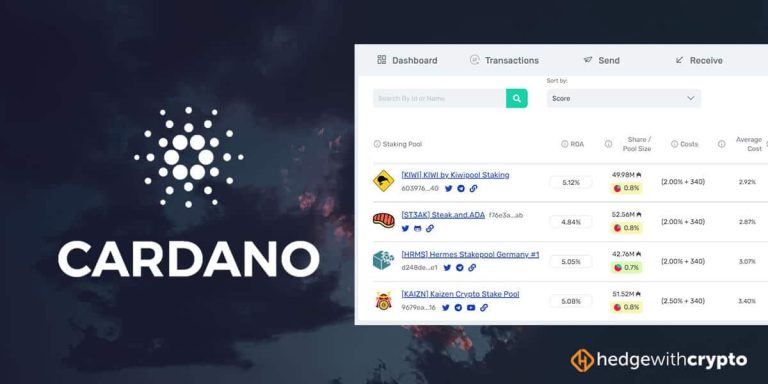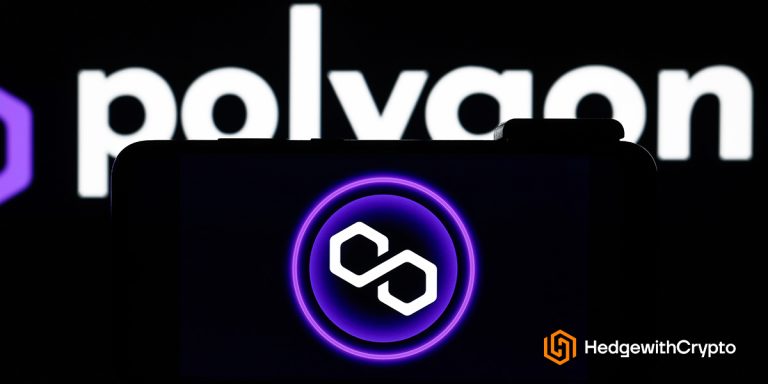We may earn a commission from links on our site, but this doesn’t affect our reviews. Learn more.
Hedge With Crypto is an independent publisher that provides objective and free content. Articles on our site may include links to our partners. If you click on these links, we may earn a commission. However, our editorial content remains unbiased, reflecting our own opinions or the general information available. For more information on our company policies, read the Affiliate Disclosure, Privacy Policy, and Terms & Conditions.
Where & How To Stake Flow
Hedge With Crypto aims to publish information that is factual and accurate as of the date of publication. For specific information about a cryptocurrency exchange or trading platform please visit that provider’s website. This information is general in nature and is for educational purposes only. Hedge With Crypto does not provide financial advice nor does it take into account your personal financial situation. We encourage you to seek financial advice from an independent financial advisor where appropriate and make your own inquiries.
TABLE OF CONTENTS
The Flow blockchain follows an advanced version of the proof-of-stake consensus mechanism and relies on several nodes to process a transaction. Since becoming a validator requires technical knowledge, it is inaccessible to everyone. However, individuals can participate as delegators by contributing their crypto to staking pools and earning staking rewards in proportion to the number of tokens delegated through leading staking platforms and wallets.
Flow can be staked using a cryptocurrency exchange or wallet. Based on our assessment, these are the best four places to stake FLOW to generate free crypto yields.
- Binance (overall best platform to stake FLOW)
- Kraken (best place to stake Flow for beginners)
- OKX (best FLOW staking rewards)
- Portto (best mobile app to stake Flow)
This Is Where You Can To Stake FLOW
1. Binance
Binance is one of the first choices of exchange among investors when it comes to investing in crypto because of the numerous features it supports, as well as being the number one exchange in terms of volume. Arguably, the platform has the most coins to stake, including Flow. Binance announced Flow staking on the platform only a few months back with three staking products.

At the time of launch, the products with 30, 60, and 90 days lock-in periods. However, there is an addition of a new flexible product that offers 2% APY without a definite lock-in period. Meaning that users can choose to stake their crypto without having to commit to a specific duration. The current Flow staking rewards on Binance are:
- 2% APY (flexible)
- 5.60% APY (30 days)
- 7.29% APY (60 days)
- 12.79% APY (120 days)
One thing to note is that a minimum of 0.1 FLOW is required for all of the products. In addition, the Flow staking pools are on a first-come-first-serve basis. Therefore, the staking pools can run out, but there is a ‘quota' to check. At the time of writing, the 30 and 60-day staking products for Flow were sold out.
Among all the staking exchanges listed in the guide, Binance is the best choice since you can easily purchase FLOW tokens on the platform and stake them there. The only thing to keep in mind is that if you redeem your rewards before the completion of the locking duration, you will have to forgo all rewards earned to date. Moreover, Binance does not have a staking commission fee, unlike other exchanges.
For more information, read our full Binance review.
2. Kraken
Kraken was among the first few exchanges to support Flow staking and offered a record 20% staking reward during its initial offering. The token was launched on the platform through an ICO, although users in the US and Canada couldn’t access it.
The current staking rewards for FLOW on Kraken range between 6% and 9% APY, with a minimum requirement of 0.00000001 FLOW. There are currently two FLOW staking products, FLOW and FLOWH. Tokens staked on FLOW are fully transferable which means that they can be staked, un-staked, or withdrawn from the wallet. On the other hand, tokens staked using the FLOWH are essentially locked and cannot be moved.

The aspect that distinguishes the FLOW staking features from other platforms is its ease of use. Unlike popular staking platforms like Binance and ByBit, investors can stake and unstake FLOW tokens in just a few clicks using the visually appealing interface. Overall, Kraken is preferred for beginners to passively generate FLOW tokens from staking.
Kraken is one of the more reputable exchanges that provide premium fiat-to-crypto and crypto-to-crypto trading services. While its trading features are world-class, its staking products are lacking compared to Bybit and Binance. However, Kraken does have a 15% staking fee on all products, which should be factored into any decision-making process. Moreover, Kraken has recently terminated its staking service within the USA.
For more information, read our full Kraken review.
3. OKX
OKX is a global cryptocurrency exchange (except the United States) popularly known for its trading fees. There are more than 350 cryptocurrencies available to trade on the platform, while users can stake 79 cryptocurrencies with multiple product options, including FLOW. Most staking platforms don’t have more than four variations when staking, but OKX has six product types to stake Flow with a maximum APY of 17.69%.

OKX lock-in periods for staking Flow start at 15 days, followed by 30, 60, 90, and 120 days, with yields ranging between 5.40% APY (15 days) and 17.69% APY (120 days). A Flexible option is available; however, the ability to redeem coins at any time comes at a price with a lower offered yield of 4.89% APY. The 15-day term is popular and was sold out at the time of writing.
Like Binance, staking opportunities on OKX are presented on a first-come, first-served basis, where some products may be sold out. Since lock-in periods for FLOW are as long as 120, the yields that investors can obtain are comparatively high compared to other staking platforms. OKX is an attractive FLOW staking option if investors want high staking returns.
For more information, read our full OKX review.
4. Portto
Portto is a cross-chain smart contract wallet for mobile users that enables users to interact effectively with cryptocurrencies, NFTs and decentralized applications. Portto (formerly Blocto) aims to counteract difficult user experiences commonly seen in the crypto world by providing a simplified user experience to promote mass adoption.
Native to the Flow blockchain, Portto's use cases are focused primarily on gaming. However, users can hold tokens native to multiple blockchains in the wallet. In addition to this, the wallet can also be integrated by dApps developers into their applications. Moreover, it comes in both custodial and non-custodial versions as well.
At the time of writing, Portto offers a 4.48% APY for staking FLOW, which is not as high as the crypto exchanges on this list. Although the rewards are slightly below par, the main advantage that Portto presents is its Auto-Restaking feature. This feature, which can be toggled on or off using the mobile app, tells the app to automatically stake the crypto rewards that are passively generated, resulting in a compounding effect.
FLOW Staking Exchanges Compared
The table below compares the staking exchanges and wallets for FLOW. These figures are estimates only, and they do not take into account the network inflation metrics. Actual rewards can be lower than what is stated here.
| PLATFORM | NUMBER OF COINS | STAKING FEE | RATING | PROMOTION | WEBSITE | REVIEW |
|---|---|---|---|---|---|---|
|
|
None |
None |
Rating
We provide an overall weighted average rating out of 5 stars. Our ratings are based on objective criteria like the ease of use, fees, deposit methods, customer support and availability. Our reviews are not influenced by 3rd parties. Click here for further information about our rating methodology and a full list of categories we review against. 4.8 / 5 |
Up to $100 welcome bonus |
Visit Binance | Binance Review |
|
|
None |
15% |
Rating
We provide an overall weighted average rating out of 5 stars. Our ratings are based on objective criteria like the ease of use, fees, deposit methods, customer support and availability. Our reviews are not influenced by 3rd parties. Click here for further information about our rating methodology and a full list of categories we review against. 4.8 / 5 |
None available at this time |
Visit Kraken | Kraken Review |
 OKX OKX
|
None |
None |
Rating
We provide an overall weighted average rating out of 5 stars. Our ratings are based on objective criteria like the ease of use, fees, deposit methods, customer support and availability. Our reviews are not influenced by 3rd parties. Click here for further information about our rating methodology and a full list of categories we review against. 4.4 / 5 |
None available at this time |
Visit OKX | OKX Review |
What Is Flow?
Flow is a proof-of-work blockchain that enables fast and cost-effective transactions. Its native token is FLOW. Dapper Labs launched the Flow blockchain, which has processed over $20 million in transactions and now hosts a range of decentralized applications.
FLOW, the native token of the blockchain, has a market cap of over $1.6 Billion and doesn't have a cap on the circulating supply, while the current supply stands at 1.04 Billion. The total supply of FLOW is set to increase by 3.75% per annum according to the website.

This Is How Much Can You Earn
Investors can earn returns between 2% and 17.69% APY at the time of writing. The highest FLOW staking return can be found on OKX with a 120-day locked duration. The exact return for staking flow depends on the duration of the lock-in period or if a flexible term was selected.
Typically, longer staking durations, between 90 and 120 days, attract the highest staking profits from crypto exchanges that support the PoS protocol. For example, staking FLOW on OKX for 120 days gives a 17.69% APY. On Binance, the maximum rewards are 12.79% for a locking period of 90 days.
Conversely, investors who prefer to stake and unstake FLOW anytime can subscribe to a flexible staking arrangement. The staking rewards are much lower and range between 2% APY (Binance) and 6% APY (Kraken).
Pros And Cons Of Staking Flow
Flow is among the top coins to stake according to CoinMarketCap. However, if you’re still unsure of whether or not you should stake your flow, here’s a quick list of pros and cons that will help you make the decision.
FLOW staking pros:
- The APY rates have remained relatively consistent over the years since its launch
- The Flow blockchain was introduced as an Ethereum competitor and has thus far proved its credibility by effortlessly supporting decentralized applications on the network while charging relatively lesser transaction fees
FLOW staking cons:
- While the APYs on Flow are appealing enough, they aren’t the best in the market and thus don’t make up for the preferred choice of coins to stake among investors
- The FLOW token has historically displayed a declining trend, and this might lead to investors losing value on their tokens while they have their crypto locked up in staking pools
- FLOW is inflationary in nature as its supply keeps on increasing with time. This is a downside when compared to deflationary tokens like Ethereum, that burn a share of their tokens to help increase the price
There Are Risks Involved
Staking cryptocurrencies such as FLOW are often categorized among the riskier assets due to the lack of regulation and the high volatility the markets tend to exhibit. Some of the key aspects to consider when staking FLOW include:
- APYs aren’t stable: When staking FLOW, it's important to remember that the APYs offered at the time of staking aren’t stable and are bound to change due to market volatility.
- Risk of Attacks: It’s not uncommon for people to lose their money to crypto attacks, either on the network that affects the entire ecosystem or personal hacks that deprive a user’s wallet of all the crypto it holds. Keep the sensitive information related to your wallet, such as the key, safe & use legitimate exchanges when dealing with cryptocurrencies.
- Mandatory commitments: Users often choose the 60/90-day option when staking their crypto, and this means locking in their crypto for those many days. During this, if the price of the token shows high volatility, they might incur some losses- due to the decreasing price of the token. It’s crucial to take this into account before locking your crypto for a fixed duration.
These risks are common to most cryptocurrencies and often negligible to active investors. However, beginners should pay attention to these factors and make investment decisions accordingly. For a full list of crypto staking risks, read this article.
How To Stake FLOW Tokens
1. Staking FLOW on a Crypto Exchange
Investors can stake their FLOW tokens on several exchanges, and the process is similar on each platform. For this tutorial, we’ll be looking at how to stake FLOW on Binance.
- Create an account on a crypto exchange that supports Flow staking, such as Binance.
- Provide basic personal details and complete the KYC process.
- Purchase or transfer FLOW tokens to the wallet.
- Navigate to “DeFi Staking” and find FLOW from the list as the crypto to stake.
- Click on the “Stake Now” button (unless it is sold out), choose between the Flexible or one of the Fixed Term options, and enter the amount of FLOW to stake.
- Click “Stake Now” to finalize the arrangement and start staking FLOW tokens.
2. Staking FLOW using a Wallet
The Portto wallet helps users interact with their crypto, NFTs as well as dApps, and users can hold tokens across multiple blockchains. The wallet is made for both experts as well as beginners, and it’s really easy to stake FLOW on the platform.
Here is a quick tutorial explaining how to stake FLOW on Portto:
- Download the Portto app on an iOS or Android mobile device and create an account.
- Transfer FLOW tokens to the Portto wallet. The platform advocates using CoinList for this purpose.
- The deposited FLOW tokens will be displayed as a “Confirmation Staking Interface”. Click on the “Stake” option to begin staking.
- Choose “Auto-Restaking” for Portto to automatically stake FLOW tokens that are passively generated.
- Click “Stake” to commence the staking of FLOW tokens.



